The resurgence of the American armed citizen in recent decades has ushered in a renaissance for firearms and associated gear designed specifically for personal defense and concealed carry. At the same time, nearly two decades of war in the Middle East have produced countless lessons and innovations, many of which are cross-pollinated with commercial advancements spurred by competitive shooters, trainers and enthusiasts, particularly in the action shooting and long range disciplines. None of those pursuits exist in a vacuum, and many lessons and technologies have been shared and adapted across the board.
One company that caters to the full firearm spectrum is Trijicon. The Wixom, Mich., electro-optics manufacturer is among a select group of firms boasting honest-to-goodness battle-proven sights, the company’s ACOG is perhaps the best known, and most-produced, with more than 1 million having been delivered. Aside from its military exploits, Trijicon is also a trusted name among law enforcement, shooting sports competitors and armed citizens thanks to its reputation for reliability, and a catalog that includes all manner of firearm sighting solutions, from tritium-power iron sights to sophisticated magnified optics, and even sights and scopes designed for archery use. One of Trijicon’s most popular offerings, in any market, is the RMR—Ruggedized Miniature Reflex sight. The RMR has found favor for its ease of use—it’s a simple, 1X red-dot, available with a range of reticle sizes—it’s robust construction, and its suitability for use atop nearly any platform—rifle, pistol or shotgun. In particular, the past decade has seen a substantial increase in demand for pistol-mounted red dots, and the transition of that technology from the competition ranges to the holsters of armed citizens. The RMR, with its compact size and durable design, was one of the earliest offerings suitable for duty or personal-defense use, and it has been a market leader since its introduction.
By now, most will be acquainted with some of the benefits of using a red-dot optic atop a pistol, and I think we can agree that those benefits extend to audiences beyond those “with aging eyes,” the most targeted demographic in recent years. The chief advantage, after all, is that a reflex sight eliminates the hardest and most complex aspect of pistol shooting—front sight focus—and provides instead an easy and intuitive aiming arrangement. Traditionally, a shooter must be aware of three focal planes—rear sight, front sight and target—perfectly align all three, and simultaneously focus strongly on just one (the front sight) while subordinating the others. With a red dot, shooters focus on the target—which is the natural inclination—and simply superimpose the reticle upon it. With a good reflex sight, it doesn’t matter where within the glass the reticle is positioned, as long as the dot is on the target, the pistol is aligned for a good shot. 
Given such an advantage, it’d be fair to wonder why red dots are not standard issue. Certainly, they are becoming much more common, and increasingly firearm manufacturers are shipping guns from the factory either in optics-ready configurations, or with red dots already installed and ready to go. But there are certainly limiting factors when it comes to using optical sights on handguns. Tradition is one, pistol optics are still very new compared to iron sights. Also, illuminated optics are reliant upon their power source—in the case of the RMR, a CR2032 battery—which, depending on how you see it, adds another maintenance item to be monitored, or introduces a new possible failure point to the whole platform (though an arrangement of co-witnessing iron sights should assuage the more dire perspective). Also, while new shooters may pick up red dot use with aplomb, many seasoned shooters find that some retraining is required in order to effectively use a pistol-mounted optic. The optic rides the slide differently, and often higher, than traditional iron sights. And, while simple to use in theory, the lens or window of pistol sights is fairly small, and many find themselves struggling to find the dot during presentation or forced to chase the dot after recoil. Like anything, these issues are easily remedied through training, but the time required and cost of ammunition—not to mention the cost of the optic itself—represent a real barrier to entry for those already comfortable with shooting irons.
While these considerations can’t be eliminated from the optics v. irons discussion, they can be mitigated, and that is exactly what Trijicon has accomplished with its newest red dot, the SRO—Specialized Reflex Optic. Like the RMR, the SRO would be at home atop nearly any ballistic platform, but pistol shooters have the most to gain from the optic’s advancements.
The biggest difference between the RMR and the SRO is also the SRO’s largest physical feature—the viewing lens. Enclosed within a round, extended housing, the lens is taller and wider than the RMR’s viewing pane thanks to its more circular design, and provides a comparatively wider field of view. The lens is also clearer than competitive red dots, and while certain coatings are necessary to properly protect the glass and reflect the reticle, Trijicon has managed to reduce the tint that such coatings necessarily imbue. The end result is a large, clear viewing pane that makes it much easier to find the dot upon firearm presentation and keep the dot within the window during movement and recoil. In short, it’s just easier to use than smaller optics.
Besides it’s larger lens, the SRO also incorporates several quality of life enhancements. For one, it utilizes the same mounting foot print as the RMR, so it is compatible with virtually all pre-existing RMR mounting arrangements. (The only consideration that would restrict its use is the SRO’s extended front end. Users should be careful not to cover ejection ports, and rear iron sights located in front of the optic mount may prohibit the use of the SRO.) The height of the unit’s base is also nearly identical to the RMR, so iron sights that co-witness with an RMR should work equally well with the SRO.
The unit’s operation also received some thoughtful changes, chief among them is the top-loading battery compartment. As with the RMR, the SRO runs off of the commonly available CR2032 battery, but no longer will users need to dismount the optic from the firearm in order to replace its power supply. The SRO is advertised as having a three-year life when used at reticle-illumination setting number four. In all there are eight illumination levels, include two night-vision-compatible settings, and the SRO features two new modes of operation. In Lock Out mode, the user is choosing to rely upon the SRO’s auto-adjustment to provide the appropriate level of illumination—the familiar side-mounted adjustment buttons are “locked out” in favor of the auto-adjust. With the Lock In mode, the user selects their preferred level of illumination, and disables both the adjustment buttons and the auto-adjust function. 
I had the opportunity to use pre-production samples at a two-day shooting event at the JL Bar Ranch in Sonora, Texas, prior to the SRO’s launch. From the jump I found the SRO to be easy to use, utterly reliable and extremely durable. I made a point to really run the optics hard, and came away very impressed by its performance, and eager to get my hands on a few, true-production models for more extensive testing.
For more of my commentary on the new Trijicon SRO, be sure to check out the video above, and be sure to stop by trijicon.com for more information.


























